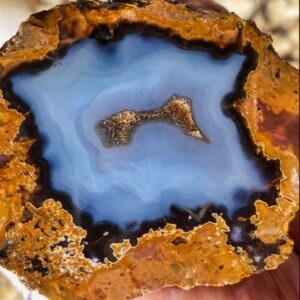Thundereggs, or Thunder Eggs, are one of the planet’s most unusual and beautiful geological formations. They might look like drab and boring rocks on the outside, but you know what they say about judging a book by its cover… well you shouldn’t. Once these incredible eggs are opened, they’re a site to behold.
Many amateur rockhounds have walked right past Thunder Eggs while scouring different areas because they didn’t know what they should be looking for. Never fear; when you’re done reading this, you should be able to spot them much more easily.
Oregon Thunder Egg
Thunder Eggs are Oregon’s state rock. These orange-sized mud balls become filled with beautiful layers of Agate over time. Once you cut them open you’ll notice a variety of colors ranging from blues to grays to whites and if you’re really lucky you’ll get one with druzy Quartz crystals in the middle. If you’re not into traveling for hours, manual labor, and getting dirty then you can always buy a whole Thunder Egg online from various rock shops. Don’t forget you’ll need a way to open it up via a diamond saw blade or one of those rachet-style rock crushers. Personally, I prefer a diamond saw blade, and then make sure you polish the faces.

Where Are Thunder Eggs Found?
Volcanic Rhyolite determines where Thunder Eggs can be found, period.
Water seeps through the porous rocks carrying silica in solution, causing them to form within the lava. The deposits are carried by the water and fill the cavities, which adds a darker matrix material and a Chalcedony or an Agate inner core.
This type of rock is found in areas with intricate and complex histories that include shifting environmental factors. They can occasionally be spotted in streams and rivers, where the water may have carried them.
Some well-known locations where Thunder Eggs have been found include Germany, Argentina, Canada, Poland, Ethiopia, Romania, and the United States. Some of the necessary conditions for forming these unique stones include magmatic composition, types of rocks in the area, groundwater geochemistry, pressure, depth, and temperature.
In Schneekopf, near Gehlberg, the hard igneous rocks with fine-grained crystals or porphyry-based mountain is volcanic in origin, which is the perfect area to find eggs. However, the thunder eggs in Mount Lyall, in British Columbia, Canada, have a volcanic outcrop as the host rocks.
Oregon, New Mexico, Washington, Arizona, and Idaho are five of the top states in the US to find Thunder Eggs. Each state has various locations where eggs can be found, and once you know where to look, they shouldn’t be too difficult to find.

How To Identify A Thunder Egg
Thunder Eggs are stunning and fascinating formations found in various parts of the world. They’re formed from volcanic ashes and different other sorts of debris. These eggs can contain beautiful bands of multiple minerals.
But how do you identify them? We’ll tell you all about it; let’s dig into a few things to consider.
- Thunder Eggs are round and usually have a rough, bubbly surface.
- The size of these beauties ranges from a few inches to several feet in diameter.
- Due to the mineral content within a Thunder Egg, they can be quite heavy or weighty.
- The surface is often rough, with a pitted exterior made up of volcanic ash and other debris.
- Thunder Eggs have an interior characterized by layers or bands of minerals that can form intricate designs and patterns.
- The colors of the minerals in an egg can vary widely and can include shades of gray, white, green, red, and blue.
- Thunder Eggs are relatively durable and hard, with a hardness of about 6.5 to 7 on the Mohs hardness scale.
- These stones make a distinctive sound similar to thunder when struck, which is why they are called Thunder Eggs.
Are Thunder Eggs Rare?
While Thunder Eggs are popular and can be found in various areas of the world, they’re actually rare.

How To Open A Thunder Egg
While you won’t need a bunch of specialized equipment to cut Thunder Eggs open, you will need a good saw.
A rock saw is one of the hardest things to improvise for many of you at home or in the field. A rock saw with an appropriately sized blade does the best. Still, a cheaper tile saw can also be used to open Thunder Eggs.
If you’re entirely new to this, it might be best to find a cheap tile saw and put a lapidary blade on it. This saves you time and money and will do a decent job. If you’re really into rocks and minerals then I’d suggest purchasing a dedicated diamond saw, roughly 10 inches or larger with an autofeed.
Don’t forget that lapidary clubs usually have access to lapidary saws, so if you have a local rock and gem society in the area then you should reach out.
Thunder Egg vs. Geode
Let’s talk about the differences between Thunder Eggs and Geodes.
Thunder Eggs
- Outer Shell Color: The color of Rhyolites is pale colored, often light gray, tan, red, pink, or reddish-brown.
- Genesis: Volcanic.
- Mineral Composition: Microcrystalline varieties of Quartz – Chalcedony, Agate, Jasper.
- Crystal Presence: Materials are cryptocrystalline.
- Interior: Mostly solid.
Geodes
- Outer Shell Color: Any color. From white, yellowish-white, and orange to gray and black.
- Genesis: It can be volcanic and sedimentary.
- Mineral Composition: Rock Quartz, Amethyst, Ametrine, Celestine, Calcite, Hematite, Magnetite, Pyrite, Barite, Millerite, etc.
- Crystal Presence: Well-formed faceted crystals.
- Interior: Hollow.
- Identify Enstatite - March 12, 2024
- Identify Cerussite - March 3, 2024
- Identify Bytownite - February 18, 2024

5 Responses
Thank you for the rock identification n appraisal information.
Sonia – Happy to help
Thank you for the descriptions of geodes and thundereggs…nice to know…
Thanks for the update God bless
Can Geodes and thunder eggs be found in MA or around New England?